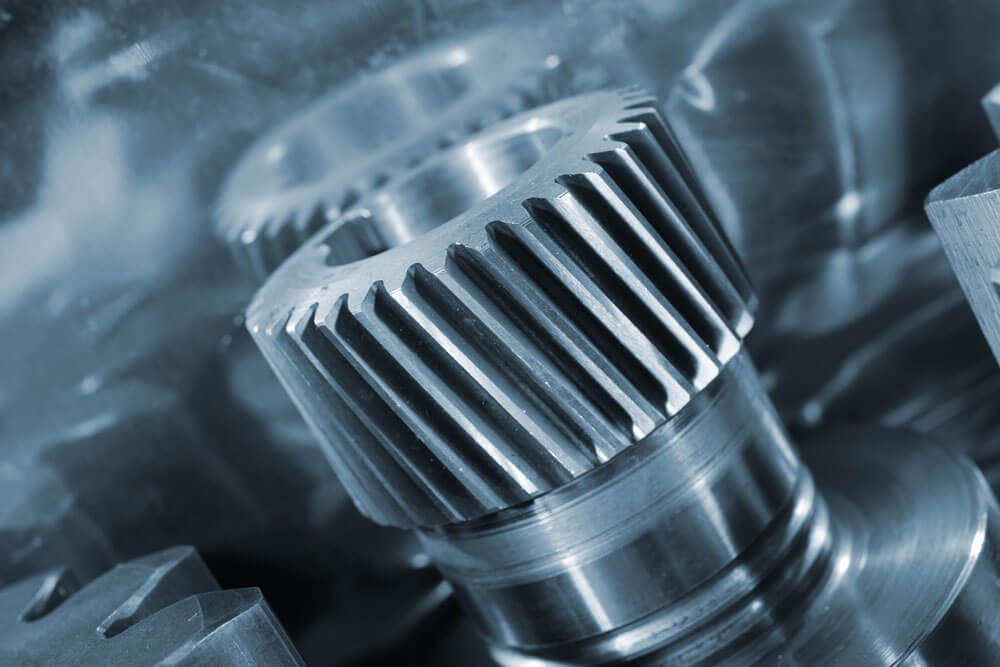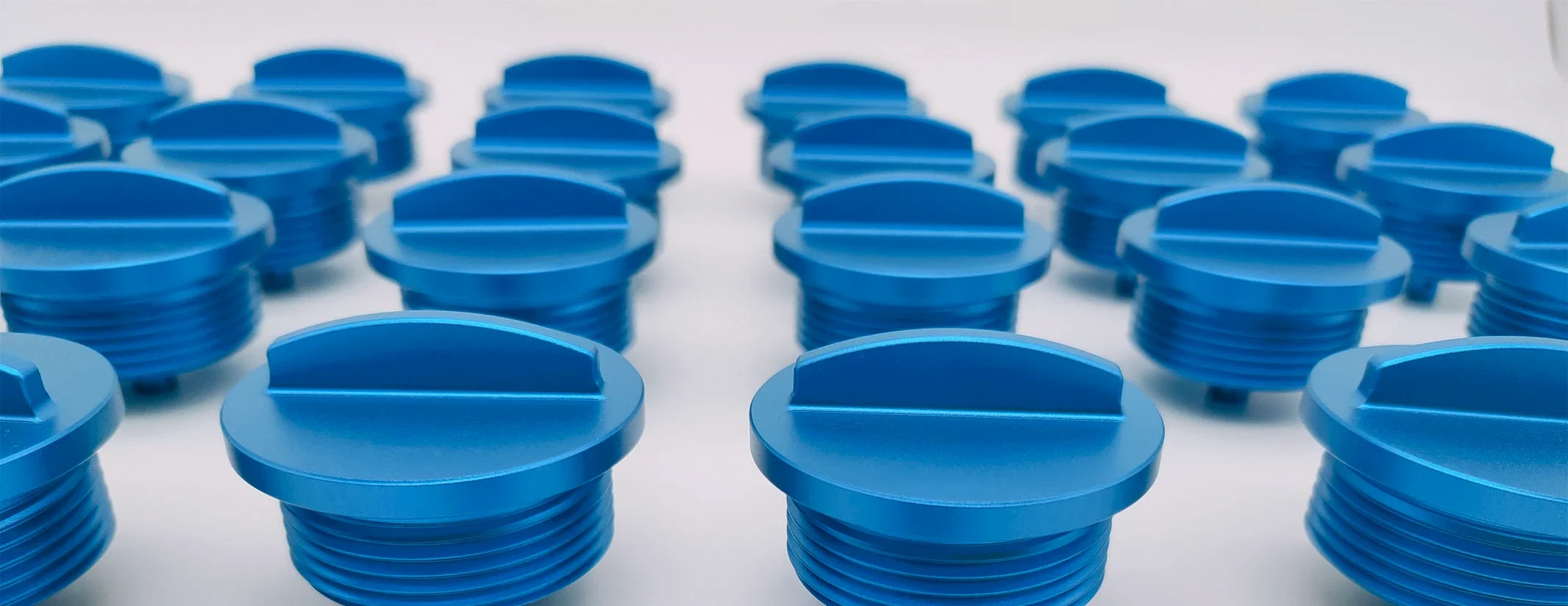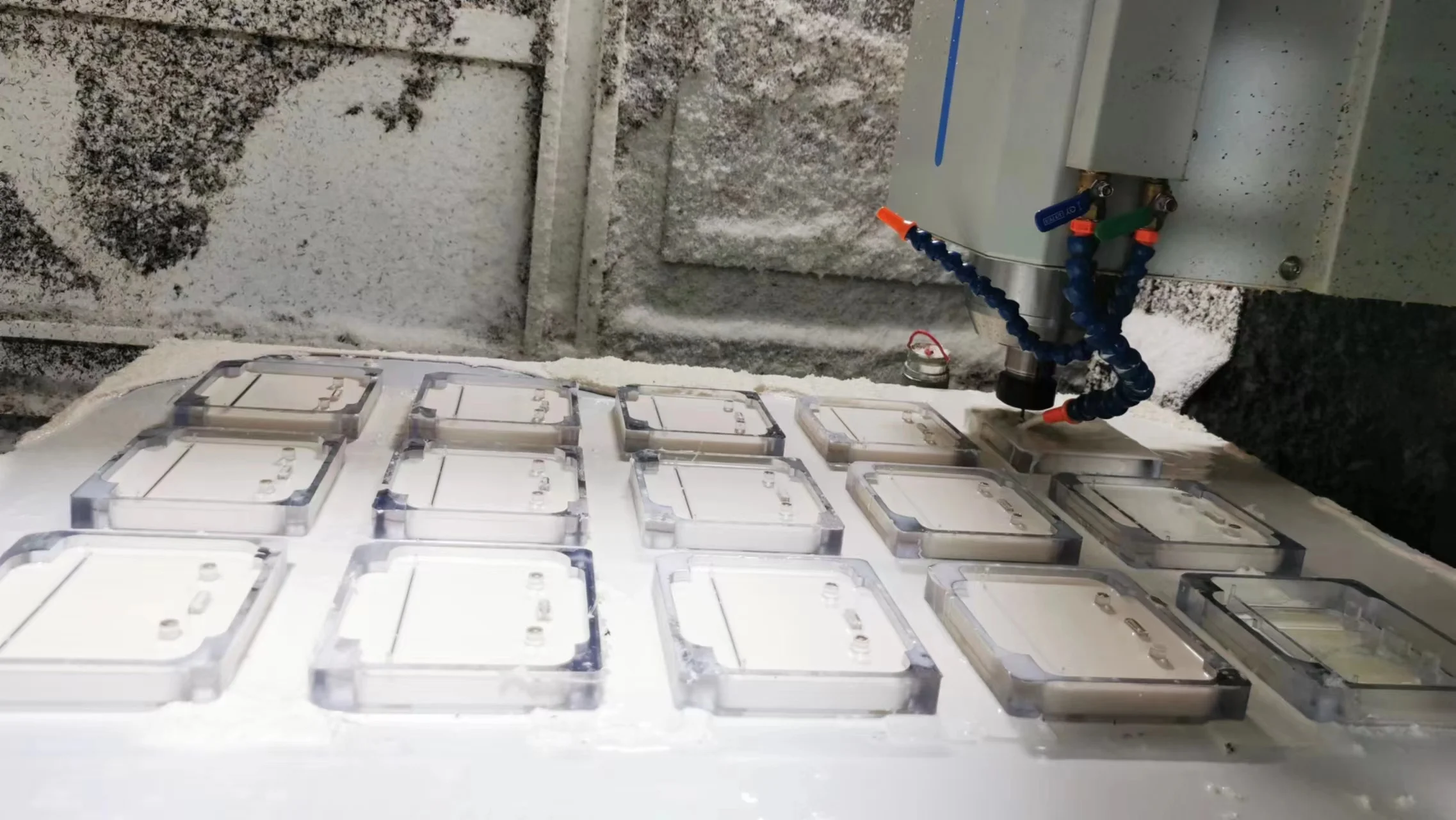Table of Contents
CNC machining ensures precise, lightweight, and durable drone parts, including frames, motor mounts, and propellers, with tolerances as tight as ±0.005mm.
Suppliers like Ecoreprap enable fast prototyping and scalable production using aluminum, carbon fiber, and engineering plastics.

What is CNC Machining for Drone Parts?
CNC machining for drone parts is a computer-controlled manufacturing process that produces precise, custom components essential for drone performance.
It starts with designing the part using CAD software, followed by programming the CNC machine via CAM to guide cutting tools.
The machine then mills, drills, or carves materials—commonly aluminum, carbon fiber, or plastics—into parts like frames, motor mounts, and propellers with micron-level accuracy.
Post-machining processes like polishing or coating improve durability.
CNC machining ensures tight tolerances, lightweight yet strong parts, rapid prototyping, and reliable production, making it vital for high-quality, efficient drone manufacturing.
Key Applications in Drone Parts Manufacturing
1.Drone Frames
In drone manufacturing, CNC machining plays a crucial role in producing drone frames that balance rigidity and weight optimization.
The frame acts as the drone’s backbone, requiring strength to maintain structural integrity during flight while being lightweight to improve maneuverability and battery life.
CNC machining allows the creation of complex geometries that traditional methods cannot easily achieve, enabling customized designs with precise dimensions.
By using materials like aluminum alloys and carbon fiber composites, CNC machining produces lightweight drone frames that are both durable and rigid, enhancing overall drone performance and reliability.
2.Drone Frames
CNC machining is key to manufacturing drone arms, ensuring stability and vibration resistance critical for flight control.
With CNC technology, arms are produced with uniform, high-precision dimensions, reducing imbalance and enhancing overall drone performance.
Materials like aluminum and carbon fiber are commonly used to achieve a strong yet lightweight structure.
CNC’s ability to create complex, aerodynamic shapes improves durability and reduces air resistance.
The precision and repeatability of CNC machining make drone arms reliable components that contribute to smoother, more stable flights in diverse drone applications.
3.Motor Mounts
CNC motor mounts in drone manufacturing are precision-machined components that ensure accurate motor alignment, critical for optimal drone performance and minimizing vibrations.
These mounts are typically produced from lightweight, durable materials like aluminum alloys, with CNC machining achieving tight tolerances often around ±0.005mm.
This precision allows motors to be securely housed and perfectly aligned, maintaining balance and stability during flight.
The durability and exact fit provided by CNC machining extend the drone’s operational life and enhance flight efficiency.
Custom CNC motor mounts also allow design flexibility for various drone models and applications, making them essential for reliable, high-performance drones.
4.Drone Housings and Casings
Drone housings and casings require CNC machining for protective, lightweight designs that combine durability and precise component integration.
CNC enables complex cutouts and intricate geometries, allowing seamless accommodation of electronics, sensors, and cooling features while maintaining structural integrity.
Materials like aluminum alloys, titanium, and composites are used for strength and weight optimization.
Precision CNC machining ensures tight tolerances and smooth finishes, essential for impact resistance and environmental protection.
Customized drone enclosures produced by CNC machining support advanced designs, modular assembly, and enhanced aerodynamics, making them crucial for reliable drone operation in diverse conditions.
Advantages of CNC Machining for Drones
CNC machining provides high-precision, repeatable manufacturing for drone parts, ensuring tight tolerances and optimal fit for components like motor mounts and propellers.
It supports lightweight, strong materials such as aluminum, carbon fiber, and titanium, enabling both prototypes and scalable batch production with consistent quality.
- High precision and repeatability ensure tight tolerances and consistent quality.
- Supports both single-piece prototypes and efficient batch production.
- Wide material versatility including carbon fiber, aluminum, and titanium.
- Enables complex geometries and custom designs for advanced drone parts.
- Improves drone flight performance by producing lightweight yet strong components.
- Reduces production time and material waste, enhancing cost-effectiveness.
- Enhances durability and reliability for demanding drone applications.
- Facilitates rapid design iteration and scalability in manufacturing.
- Provides excellent surface finish quality for better aerodynamics and assembly.
- Supports integration of multiple components into single, complex parts.
These benefits make CNC machining indispensable in modern drone manufacturing.
Tolerance and Accuracy Considerations
Tolerance and Accuracy Considerations in CNC Machining for Drones:
- Typical tolerances achievable are around ±0.005mm (±0.0002 inches), considered very tight in manufacturing.
- Such precision is crucial for ensuring drone component uniformity and exact fit, leading to balanced structures.
- Accurate parts minimize vibrations and imbalances, which greatly improves flight stability and extends operational safety.
- Tight tolerances allow reliability in aligning motors, propellers, and structural frames critical for performance.
- Precision machining enhances aerodynamic efficiency by enabling better surface finishes and component integration.
- CNC machining’s accuracy surpasses many other manufacturing methods like 3D printing, making it preferred for high-performance drones.
- Variations beyond tolerance can lead to mechanical failures or degraded flight control, underscoring the importance of precision.
Maintaining these tight tolerances is essential for safe, stable, and reliable drone operation.
Prototype vs. Mass Production
Prototype vs. Mass Production in CNC Drone Manufacturing:
- Flexibility: CNC machining is ideal for low-volume prototypes due to easy design changes without costly tooling.
- Rapid Iteration: Prototypes can be quickly produced and tested, accelerating development cycles.
- Scalability: CNC supports transitioning from prototyping to larger production runs with consistent quality.
- Cost-Effectiveness: Low setup costs benefit small production; economies of scale reduce costs in mass production.
- Consistency: Mass production via CNC ensures repeatability and precise tolerances across batches.
- Material Versatility: Same materials (aluminum, carbon fiber, titanium) are used for prototyping and production.
- Customization: CNC enables bespoke parts tailored to specific drone models or applications at any scale.
- Time Efficiency: Automated CNC processes reduce lead times from prototype to production.
- Quality Control: CNC maintains high standards throughout all production volumes.
- Adaptability: CNC machining quickly accommodates design modifications during scale-up, supporting innovation.
CNC machining vs 3D printing for drones
CNC machining and 3D printing are two prominent manufacturing methods for drones, each with distinct advantages:
1.CNC machining offers
- Tighter tolerances (around ±0.005mm) for high-precision, reliable parts.
- Superior surface finish quality.
- Greater material versatility, including metals like aluminum and titanium.
- Strong, durable components suitable for structural parts and high-stress applications.
- Better scalability for mass production.
2.3D printing excels in
- Producing complex geometries that are difficult with CNC.
- Rapid prototyping with low setup costs.
- Flexibility for low-volume, custom parts.
- Faster iteration cycles for design testing.
- Lower cost per part for small batches or one-off prototypes.
In summary, CNC is preferred for high-precision, durable, and scalable drone components, while 3D printing is advantageous for rapid prototyping and complex designs in low-volume production.
Why Choose Chinese CNC Prototyping Suppliers for Drone Parts?
Let’s start with the big picture: Why do more and more drone companies turn to Chinese CNC prototyping manufacturers?
Think of it like ordering a custom dish. Chinese suppliers not only have all the right “ingredients” (equipment, materials) but also the knack for “quick taste tests” (small-batch prototyping). Here’s the breakdown:
1.Equipment firepower
Top players here are armed with 5-axis machining centers and high-precision inspection tools – more than enough to handle drone propellers, frames, and gimbals with ease.
2.Speed to market
Send a design in the morning, get a quote by afternoon, and have samples in a week. Overseas suppliers? You might still be waiting for a reply by then.
3.Cost sweet spot
For the same precision and materials, Chinese suppliers often quote 30% less. For startups testing drone designs, that’s a game-changer.
I’ve talked to drone startups who put it bluntly: We don’t just pick Chinese suppliers for cheap prices. We pick them because they let us fail fast – and affordably.
Top 5 CNC Prototyping Manufacturers for Drone Parts in China
Top CNC prototyping manufacturers for drone parts in China include Ecoreprap (±0.005mm precision, aluminum, carbon fiber), Beska Mold (CNC, sheet metal, injection molding), Dongguan Jinjie Precision (high-precision components), and Shenzhen Sujia Technology (rapid prototyping and small batches).
1. Ecoreprap
What makes Ecoreprap stand out? They eat, sleep, and breathe drone parts.
Laser focus: 80% of their orders come from drone companies. Whether it’s consumer drone arms, industrial drone payload brackets, or agricultural drone nozzles, they’ve seen it all.
Machining muscle: With 12 5-axis machining centers, they hit tolerances as tight as ±0.005mm.
To put that in perspective: that’s 1/20th the width of a human hair – more than enough for drone parts that need to fit like a glove.
Material mastery: They handle aluminum, carbon fiber composites, and engineering plastics (PA6, PEEK – you name it).
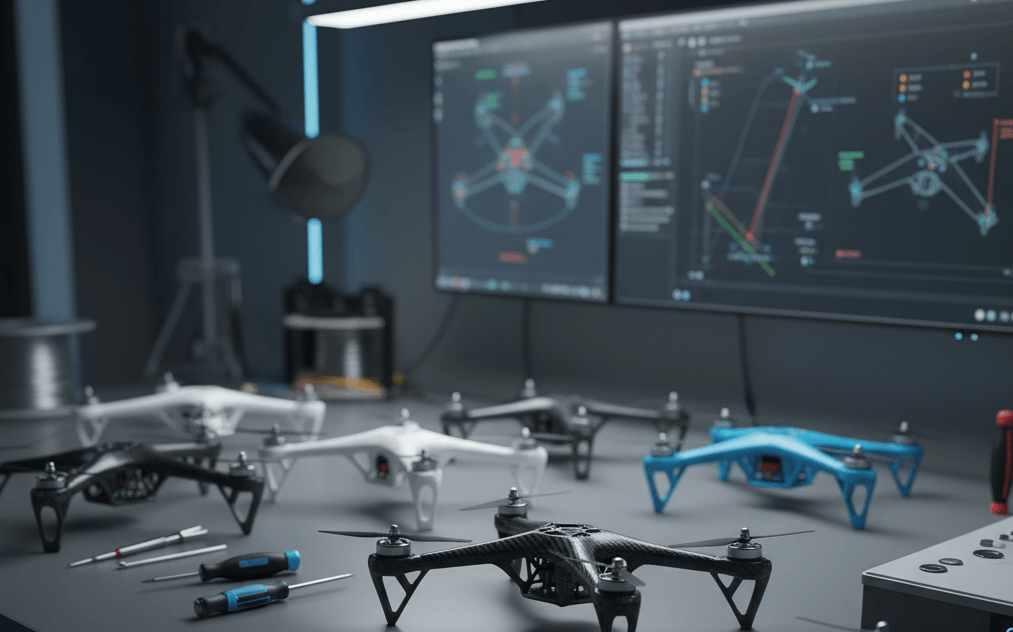
Their carbon fiber parts? A client once told me, “They shaved 20% off the weight without losing strength.
That’s the difference between a drone that crashes and one that stays airborne.
Customer feedback says it all: We sent a design with a tricky curved edge – other suppliers said it was impossible.
Ecoreprap’s engineer called back, suggested a minor tweak, and delivered samples that fit perfectly.
They didn’t just make parts – they fixed our design.
2. Shenzhen Sujia Technology
Specialty: They’re like the “Uber” of CNC machining, with a platform that connects clients to a network of factories.
Best for: Small batches (10-50 pieces) where speed is key. Need a quick prototype of a drone remote control housing? They’ll have it on your desk in 3 days.
Great for plastic parts, but for ultra-precise metal components, you might want to double-check their inspection reports.
3. Dongguan Lixing Laser
Specialty: A one-stop shop that combines CNC with laser cutting and 3D printing – perfect for drone parts needing mixed processes.
Example: Drone metal mesh covers? They’ll CNC the frame, then laser-cut the mesh in one go. No need to juggle multiple suppliers.
Precision level: ±0.01mm – solid for consumer drones, but industrial-grade projects might need tighter specs.
4. Shanghai Fuqifan Precision Manufacturing
Specialty: Military-grade precision, ideal for industrial and mapping drones where failure isn’t an option.
Claim to fame: They’ve machined gyroscope mounts for drones that withstand high-altitude turbulence without losing calibration.
Trade-off: They prefer larger orders. If you need just 2-3 prototypes, they might not prioritize you.
5. Suzhou Sandi Space
Specialty: Started with 3D printing, then added CNC – a pro at handling complex, organic shapes.
Sweet spot: Drone bionic wings with curves and grooves that other suppliers struggle to machine smoothly.
Their surface finish? Clients often say it looks polished to a mirror shine.
Material edge: They’ve got deep experience with advanced plastics like ULTEM, which is heat-resistant – perfect for drone parts near motors.
What are the challenges of CNC machining for drones?
The main challenges of CNC machining for drones include achieving extremely high precision with complex geometries, efficiently machining expensive lightweight materials like carbon fiber and titanium, maintaining consistent part quality and repeatability in low-volume, high-mix production, controlling costs and minimizing material waste, and managing tooling wear and machine maintenance to ensure reliability and safety in drone components.
- Material Selection: Balancing lightweight materials (like carbon fiber, aluminum, titanium) with strength and durability requirements is complex and critical for drone performance in various environments.
- Vibration and Micro-Movements: Small drone parts are prone to micro-vibrations during machining, impacting precision and surface finish. Specialized anti-vibration measures and machine stability are necessary to maintain tight tolerances.
- High-Mix, Low-Volume Production: Drones often require multiple models and small batch runs, demanding flexible, rapid-changeover CNC systems that can maintain quality with diverse designs.
- Precision Requirements: Achieving micron-level tolerances (±0.005mm) is essential for component fit, flight stability, and safety, adding complexity to machining processes.
- Cost and Efficiency: Minimizing material waste and labor costs while maintaining quality is essential, requiring optimized workflows and automation.
- Machining Advanced Materials: Carbon fiber machining is challenging due to its abrasive nature and cost-sensitive error margin, requiring tailored tooling and cooling solutions.
- Scalability: Scaling production without losing precision or increasing lead times is difficult given the complex part geometries and customization demands.
Overall, drone CNC machining demands a balance of advanced technology, material science, and process control to overcome these challenges and produce high-performance, reliable UAVs.
Ecoreprap – Precision CNC Components for High-Performance Drones
Ecoreprap is a China-based manufacturer specializing in CNC machining and 3D printing services for drone parts, particularly suitable for prototyping and small-batch production.
They offer high-precision CNC machining, supporting materials such as aluminum alloys, carbon fiber, and engineering plastics, suitable for drone frames, motor mounts, and propellers, with tolerances up to ±0.005mm.
How to Order Drone Parts Directly from Ecoreprap?
Ordering from Ecoreprap is as straightforward as flying a well-calibrated drone – no complicated maneuvers required.
1.Step-by-Step Process
- Share your specs: Shoot their sales team an email with your CAD file, material preference (aluminum? carbon fiber?), and quantity.
- Pro tip: Mention if it’s a prototype or mass production – they’ll tweak the quote accordingly.
- Get a custom quote: They’ll reply within 24 hours with a breakdown of costs, lead time, and any design tips (like swapping a tricky material for something easier to machine – without losing quality).
- Lock in the details: Approve the quote, agree on payment terms (they accept T/T, PayPal, even L/C for big orders), and sit back.
- Track and receive: They’ll send real-time updates on production, and once done, ship via DHL, FedEx, or your preferred carrier. Most clients get their parts in 10-14 days from order.
2.Why Order Directly?
No middlemen, no markup: Skip the trading companies that add 15-20% to the price. You pay Ecoreprap directly, so your budget stretches further.
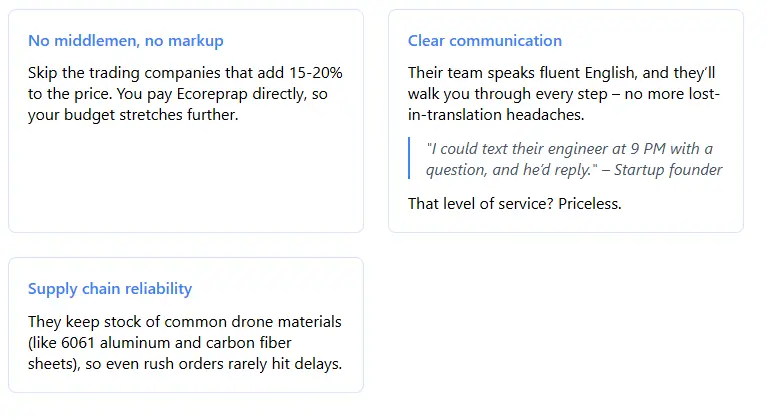
Clear communication: Their team speaks fluent English, and they’ll walk you through every step – no more lost-in-translation headaches.
One startup founder told me, I could text their engineer at 9 PM with a question, and he’d reply.That level of service? Priceless.
Supply chain reliability: They keep stock of common drone materials (like 6061 aluminum and carbon fiber sheets), so even rush orders rarely hit delays.
Summary
CNC machining empowers drone manufacturers with precision, repeatability, and material versatility, ensuring high-performance, reliable, and lightweight components.
Partnering with experienced suppliers like Ecoreprap streamlines prototyping and production, helping drones stay ahead in innovation, efficiency, and flight stability.
Verified data from the U.S. Federal Aviation Administration (FAA) Drone and UAV Manufacturing Database, official industry reports on CNC machining and UAV component production, and ISO 9001 and CE-certified precision CNC suppliers.

Lucas is a technical writer at ECOREPRAP. He has eight years of CNC programming and operating experience, including five-axis programming. He also spent three years in CNC engineering, quoting, design, and project management. Lucas holds an associate degree in mold design and has self-taught knowledge in materials science. He’s a lifelong learner who loves sharing his expertise.
